Warning: This infobox has missing parameters: parents, pronouns, children, siblings, partners, families, feathers and unrecognized parameters: era
- "When our leader falls in battle, the most worthy takes his place."
- ―Canderous Ordo
Mandalore the Ultimate, or Te Ani'la Mand'alor in Mando'a, led the Mandalorians during the Mandalorian Wars. One of the last Taung to claim the Mandalore title, and known to some as the Great Shadow Father, he regrouped the Mandalorian forces into the Mandalorian Neo-Crusaders and slowly began to conquer fringe worlds that had been left defenseless in the wake of the Great Sith War. Mandalore took full advantage of the Galactic Republic's halfhearted efforts to oppose his aggression and personally led his forces as they invaded Republic territory. Under his command, the Neo-Crusaders nearly defeated the Republic during the Mandalorian Wars, and it was only through the leadership of the Jedi Knights Revan and Malak that the tide of the war was ultimately turned against Mandalore. Revan killed Mandalore in hand-to-hand combat near the end of the war.
Biography
Early life
Mandalore the Ultimate claims the helmet of Mandalore the Indomitable.
Little was known about Mandalore the Ultimate's life prior to his assuming command of the Mandalorian clans. He was known to have been the quickest Mandalorian to ever master the use of the Basilisk war droids.[4] In the last days of the Great Sith War, he was part of the Mandalorian invasion force that attacked the planet Onderon. This assault pitted Basilisk war droids against Beast Riders lead by the Onderonian king Oron Kira, who overcame the Mandalorians and drove them onto the dreaded jungle moon Dxun. When Mandalore the Indomitable was killed in the beast-infested jungle, Mandalore the Ultimate served as part of the party that searched for him until he found his helmet.[3]
Lord of the clans
In the years following the death of Mandalore the Indomitable, the new Mandalore went on to prove himself worthy of the title "Ultimate,"[2] and, in the wake of the clans' defeat, he set about their reforging. Mandalore understood the value an environment such as Dxun's would have for training warriors, and he built a great complex among its forests. Mandalore the Ultimate thus established the inhospitable moon as the clans' new forward base of operations and from there recalled the disparate clans.[1] Though few remained to heed his summons, Mandalore was undeterred, instead choosing to increase the recruiting of other species into the fold, thereby forming a new generation of Mandalorian warriors known as the Neo-Crusaders. In time, the Mandalorian ranks swelled with warriors from countless worlds. Humans made up the majority, but species as diverse as Rodians, Twi'leks, Togorians, Kerestians, and Mandallian Giants were well represented. Under Mandalore the Ultimate's direction, the term "Mandalorian" began to signify more than just a species; it referred to a warrior culture that defined itself by its devotion to the ideal of earning honor and glory through combat.[2]
The Mandalorian Wars
Prelude
- "The Sith came to us with an offer: to fight a worthy enemy in a battle that would be remembered forever."
- ―Canderous Ordo

Mandalore The Ultimate gives a rousing speech to his followers.
About 3978 BBY, a pureblood member of the Sith species approached Mandalore, stated that he was the emissary of a powerful Sith Lord, and persuaded Mandalore to help him in his search for the tomb of the enemy of his master's ancestor. They came to the world of Rekkiad, where they discovered the tomb, and inside a crypt where the Sith took the remains for his master. Afterwards, the emissary told Mandalore of a vision his master had of the Mandalorians waging war on the Republic and conquering it. However, the Sith was really influencing Mandalore's mind with the Dark Side, so the Mandalorians wound invade the Republic to test it's strength.[5] As a result, Mandalore started a new crusade in 3976 BBY. He led his renewed forces into the Outer Rim Territories, along the edge of Republic territory,[1] sacking independent worlds and colonies such as Althir III.[4] The Mandalorian Neo-Crusaders were able to carve out a clan territory greater than that ruled by the Hutts in the span of little more than a decade. During this time, Mandalore appointed Cassus Fett as his top strategist and allowed him to lead an army of Basilisk war-mounts in the subjugation of Cathar.[6]
The Republic Senate initially failed to respond, refusing to join in the conflict unless the Mandalorians threatened to invade the Republic itself.[4] Meanwhile, Mandalore prepared to do just that. He reordered his conquered provinces to better serve as warehouses and foundries for his growing armadas. The Mandalorian clans grew more powerful than ever before, as they accumulated a huge slave labor-force and conscripted subject peoples into their ranks. As world after world was conquered by their advancing fleets, swarms of refugees began to pour into Republic space.[6]
It was not until Mandalore's army approached Taris that the Republic senators chose to make a stand and defend the Republic's extensive commercial investment in the planet. Taris was granted Republic membership, and the annexed world soon became the heart of the Republic's defense of the region. Between the years 3965 and 3964 BBY, the first minor skirmishes between Neo-Crusader and Republic forces took place along the Republic border between Taris and the Mandalorian homeworld. For months, the two galactic powers sparred with each other within the neutral Republic frontier, as the Mandalorians systematically probed the strength and resolve of the Republic military in preparation for a full-scale attack.[6]
Invasion of the Republic
- "Let them burn."
- ―Mandalore, ordering a nuclear strike on Serroco
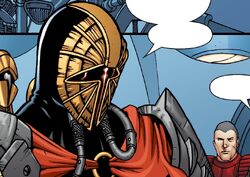
Mandalore the Ultimate, during his time aboard the Arkanian Legacy.
In 3963 BBY, Mandalore started his invasion of the Republic with a rapid conquest of Onderon, staged from nearby Dxun. Then, taking advantage of the chaos that had consumed Taris, Mandalore unleashed his long-prepared forces. His fleets poured into Republic space through three invasion corridors in adjacent sectors and caught the Republic Navy completely off-guard. The main Mandalorian fleet, commanded by Mandalore himself, began a major push towards the Republic security cordon around Taris. Splitting his forces, Mandalore simultaneously attacked Taris and the nearby planet Vanquo, thereby forcing the Republic defenders, under the command of Admirals Jimas Veltraa and Noma Sommos, to divide their efforts, causing them both to be defeated.[7] It was during this time that Republic intelligence agents sought to determine whether Mandalore the Ultimate was the same Mandalore who had arisen after the death of Mandalore the Indomitable, but they could not come to any firm conclusion.[8]
In the midst of Rohlan Dyre, aka the Questioner's death at Flashpoint, Mandalore added a dying speech to his last words and made him the model for a wide spread use of Neo-Crusader armor.[9]
Under Mandalore the Ultimate's direction, the Neo-Crusaders used nuclear devices to completely annihilate several cities on Serroco during the Battle of Serroco, dismissing any Republic delusions that the Mandalorians would not use "appropriate force" against military bases within and adjacent to major civilian population centers.[10] Soon after, Mandalore—along with most other leaders involved in the Mandalorian conflict—was invited by Arkoh Adasca, head of the Adascorp corporation, to a meeting aboard Adasca's flagship, the Arkanian Legacy, on being contacted by Demagol, under the guise of Rohlan Dyre. Mandalore told "Rohlan" of his glorious "death". Thus, he gave "Rohlan" a new set of armor so that his name would stay dead.
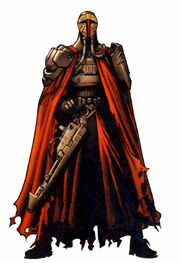
Mandalore the Ultimate.
Adasca wished to sell controllable exogorths, capable of inflicting immense damage, to the highest bidder.[9] Mandalore expressed interest in the offer, even going so far as claiming it would ensure the Mandalorians would win the war. Furthermore, Mandalore believed that the exogorths were important enough to the Mandalorian war effort that he was prepared to offer Adascorp immunity when the Mandalorians declared victory in the war, and thus absorbed every other galactic corporation. Likewise, Mandalore extended to Adasca the lucrative option of becoming the sole weapon smith of all the Mandalorian clans,[11] thus essentially being the steward of the entire Mandalorian war production effort. Adasca, however, believed that he was in a position to barter for the entire control of the Mandalorian army, effectively making him the clans' leader and boss of Mandalore. The meeting, though, was interrupted by the arrival of the Jedi Zayne Carrick and Lucien Draay, who had escaped from their captivity by Adasca aboard the Arkanian Legacy. Under the direction of Draay, the Jedi created a farce through which they made it seem that Adasca had only lured Mandalore aboard the Legacy so that the Jedi could capture the Mandalorian leader. Powerless to stop the ensuing chaos, Adasca was forced to watch as Mandalore and his warriors retreated back to their ships. Following Mandalore's withdrawal, Adasca was killed when he lost direct control of his exogorths and they plunged into the Arkanian Legacy, thus destroying the ship; despite the turn of events, Mandalore was satisfied since the slugs were not controlled by anyone.[12]
In the opening battles of the war, the Republic armadas proved to be entirely outmatched by the sheer ferocity of the Mandalorian attacks. Time and again, the Republic Navy was soundly beaten, and though the Jedi were still forbidden from entering into the conflict by the Jedi High Council, Mandalore and his warriors believed it was only a matter of time before they came to the Republic's aid, likely under the leadership of Kavar, a famed Council member.[1]
Defeat and death
- "Mandalore himself was killed at the hands of the Jedi Revan. The best of us could not defeat him!"
- ―Canderous Ordo
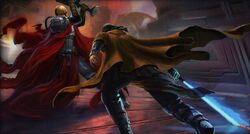
Mandalore's last stand against Revan.
Yet, it was not Kavar that led the Jedi to war, but a Jedi Knight named Revan. He and a fellow Jedi Knight, named Alek Squinquargesimus, had rallied a significant portion of the Jedi Order beneath their banner, and were soon in full command of a third of the Republic army. Mandalore, by now used to victory, was taken aback by how Revan turned the Mandalorians' own tactics against them,[6] and soon the Republic Navy began to push the Mandalorians back. Following Revan's liberation of Taris from the Mandalorians, Cassus Fett led Mandalore's forces to victory at Jaga's Cluster, only to find a significant portion of the Mandalorian army destroyed at Althir. The war was turning in the favor of the Republic.[4]
Though Revan forced a final confrontation with the Mandalorians above Malachor V in the year 3960 BBY, a scouting party saw to it that Revan himself was delayed out of system. Revan soon thereafter arrived at the battle, and as their personal fleets clashed, the two commanders met in single combat. The Jedi ultimately defeated and killed Mandalore.[1] Dying, Mandalore realized that he was really manipulated by the Sith all along, and told Revan about their involvement.[5]
Legacy
Revan not only stripped the surviving Mandalorians at Malachor V of their armor and weaponry; he took the mask of Mandalore as well, effectively fragmenting the Mandalorian clans. The Mandalorian fleets were all but destroyed at Malachor V by the Mass Shadow Generator, an experimental Republic-engineered weapon. Without leadership and direction, many went on to find work as bounty hunters or mercenaries.[1] Subsequently, there were at least two who claimed the title of Mandalore in attempts to reunify the clans. The first attempt, headed by an unidentified Mandalore, posed a threat to Revan's new Sith Empire, but many Mandalorians were unaware of this, believing that no new Mandalore had been chosen.[4] Mandalore the Ultimate's mantle eventually fell to Canderous Ordo, who had some success in his attempt to reunite the clans at Dxun.[1]
Several planets were devastated during the Mandalorian Wars, for which Mandalore the Ultimate was responsible. Notable examples included Serroco, which was thoroughly bombed with nuclear devices,[10] and Cathar, whose native species was all but wiped out.[6]
Personality and traits
- "Besides, I have learned something. Politics is simply the continuation of war by other means."
- ―Mandalore the Ultimate, to Saul Karath
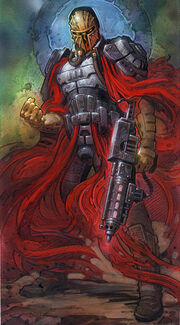
Mandalore the Ultimate poised for action.
Mandalore understood what it meant to be Mando'ade, and upon becoming Mandalore the Ultimate he set out rebuilding the society. When it became apparent that few of the original Mandalorians remained to heed his call to rebuild, he demonstrated his willingness to break established ways and set about recruiting other species into his army. Through his leadership and vision, the term Mandalorian took upon a new significance; they had become more than just a species. The clans had established themselves as part of a unique warrior culture.[2]
In addition to recruiting non-Taungs into the clans, Mandalore the Ultimate also broke with Mandalorian norms in other matters. Unlike previous Mandalores, Mandalore the Ultimate would often take political considerations into account. At the urging of Cassus Fett, his second-in-command, Mandalore decided to use the Neo-Crusader movement as a standard to hold other Mandalorians up to, as opposed to the fanatics its members had once been regarded as. Also at Fett's suggestion, Mandalore made the decision to standardize the armor of the Mandalorian Neo-Crusaders. As Mandalore himself professed, the use of the Neo-Crusader armor was useful despite his distaste for its appearance. Mandalore even considered parlaying with his enemies if it would achieve victory, as seen by his presence at the negotiations at Omonoth.[10]
In the years preceding, and also during the Mandalorian Wars, Mandalore the Ultimate established his reputation as a brazen strategist who was capable of immense destruction. He led a merciless campaign in the Outer Rim Territories, authorizing the devastation of such planets as Cathar and allowing his armies to sack the world of Althir. Even as the Republic began to respond to his aggressions, he continued to lead his Mandalorians with brutal efficiency. As the war escalated, Mandalore proved that he was willing to do anything to win his cause, even to the point of using nuclear devices to destroy entire cities.[10]
Behind the scenes
An unidentified Taung soldier appears in Tales of the Jedi: The Sith War 6: Dark Lord, taking up the mask of Mandalore the Indomitable and establishing himself as the new Mandalore. Later, an unidentified Mandalore would be mentioned several times in both Knights of the Old Republic video games by various characters and was said to have fought in the Great Sith War and led the Neo-Crusaders during the Mandalorian Wars. Eventually, this ambiguous Mandalore was identified as "Mandalore the Ultimate" in the Star Wars Insider article The History of the Mandalorians; The New Essential Chronology later established that the Taung soldier and Mandalore the Ultimate were indeed the same character.
The character of Mandalore the Ultimate would go on to be a major character in the Star Wars: Knights of the Old Republic comic series, which expounded on events surrounding the time of the Mandalorian Wars. Nevertheless, there was some confusion among fans following the release of the Star Wars: Knights of the Old Republic Handbook in the fall of 2007.[13] In the Handbook, there is provided a brief explanation of the title "Mandalore," followed by an ambiguous statement about the history of Mandalore the Ultimate. In the entry entitled "Mandalore," it was stated that some Republic officials were unsure if this Mandalore was actually the Taung soldier who replaced Mandalore the Indomitable following the Great Sith War, or if he was yet another successor who took the name and mask of Mandalore. The Knights of the Old Republic Campaign Guide, released in August 2008, would continue this ambiguity.
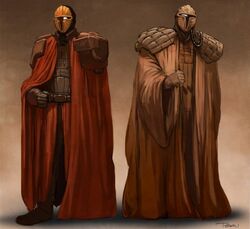
Mandalore the Ultimate (left) and Mandalore the Indomitable (right) from Knights of the Old Republic Campaign Guide.
In the original cover art of Knights of the Old Republic 15: Days of Fear, Part 3, Mandalore sported a red mask. This was changed to a golden color for unknown reasons, although author John Jackson Miller noted that "it is the case that the redder it is, those raised lines make it look more like the movie Spider-Man's mask."[14]
In the Knights of the Old Republic Campaign Guide, there is an illustration depicting Mandalore the Ultimate on the left and Mandalore the Indomitable on the right beside him. However, the caption mistakenly identifies the one on the right as Mandalore the Ultimate.[15] The Complete Star Wars Encyclopedia repeated this mistake, using the half of the image with Mandalore the Indomitable, and captioning it as Mandalore the Ultimate.
Appearances
- Tales of the Jedi: The Sith War 6: Dark Lord (First appearance)
- Knights of the Old Republic 8: Flashpoint, Part 2
- Knights of the Old Republic 10: Flashpoint, Part 3 (Mentioned only)
- Knights of the Old Republic 14: Days of Fear, Part 2 (Voice heard in vision to Zayne Carrick)
- Knights of the Old Republic 15: Days of Fear, Part 3 (Cover only)
- Knights of the Old Republic 19: Daze of Hate, Part 1 (Appears in hologram)
- Knights of the Old Republic 20: Daze of Hate, Part 2
- Knights of the Old Republic 21: Daze of Hate, Part 3
- The Taris Holofeed Special Proclamation (Mentioned only)
- Knights of the Old Republic 22: Knights of Suffering, Part 1 (Mentioned only)
- Knights of the Old Republic 23: Knights of Suffering, Part 2 (Mentioned only)
 Interference on Hyperspace (article) (content removed from StarWars.com; new link on Suvudu; backup link) (Mentioned only)
Interference on Hyperspace (article) (content removed from StarWars.com; new link on Suvudu; backup link) (Mentioned only)- Knights of the Old Republic 48: Demon, Part 2 (Indirect mention only)
- Knights of the Old Republic 49: Demon, Part 3 (Mentioned only)
- Star Wars: Knights of the Old Republic (Mentioned only)
- The Old Republic: Revan (In flashback(s))
- Star Wars: Knights of the Old Republic II: The Sith Lords (Mentioned only)
- Timeline 9: The Mandalorian Wars (Appears in hologram)
- Star Wars: The Old Republic (Codex entry)
- Template:TOR (Statue)
- The Clone Wars: Darth Maul: Shadow Conspiracy (Indirect mention only)
Sources
 "The History of the Mandalorians" — Star Wars Insider 80 (First identified as Mandalore the Ultimate)
"The History of the Mandalorians" — Star Wars Insider 80 (First identified as Mandalore the Ultimate)- The New Essential Chronology
- The New Essential Guide to Droids
- Star Wars: Knights of the Old Republic Handbook
- Knights of the Old Republic Campaign Guide
- The Complete Star Wars Encyclopedia
- The Essential Atlas
 The Secret Journal of Doctor Demagol on Hyperspace (article) (content removed from StarWars.com; new link on Suvudu; backup link)
The Secret Journal of Doctor Demagol on Hyperspace (article) (content removed from StarWars.com; new link on Suvudu; backup link)- The Journal of Master Gnost-Dural
- The Essential Guide to Warfare
- Star Wars: The Ultimate Visual Guide: Updated and Expanded
 "10 Key Battles" — Star Wars Insider 133
"10 Key Battles" — Star Wars Insider 133- Star Wars: The Old Republic Encyclopedia
- The Bounty Hunter Code: From the Files of Boba Fett (First identified as Great Shadow Father)
 Star Wars: The Essential Guide to Warfare Author's Cut, Part 2 — Ancient Coruscant on StarWars.com (article) (backup link)
Star Wars: The Essential Guide to Warfare Author's Cut, Part 2 — Ancient Coruscant on StarWars.com (article) (backup link) Mandalorian Mysteries: The Icons of Mandalore on StarWars.com (article) (backup link)
Mandalorian Mysteries: The Icons of Mandalore on StarWars.com (article) (backup link) The History of Mandalorian Armor on StarWars.com (article) (backup link)
The History of Mandalorian Armor on StarWars.com (article) (backup link)
Notes and references
- ↑ 1.0 1.1 1.2 1.3 1.4 1.5 1.6 1.7 1.8 1.9 Star Wars: Knights of the Old Republic II: The Sith Lords
- ↑ 2.0 2.1 2.2 2.3 2.4
 "The History of the Mandalorians" — Star Wars Insider 80
"The History of the Mandalorians" — Star Wars Insider 80
- ↑ 3.0 3.1 3.2 Tales of the Jedi: The Sith War 6: Dark Lord
- ↑ 4.0 4.1 4.2 4.3 4.4 4.5 4.6 Star Wars: Knights of the Old Republic
- ↑ 5.0 5.1 The Old Republic: Revan
- ↑ 6.0 6.1 6.2 6.3 6.4 6.5 6.6 The New Essential Chronology
- ↑ Star Wars: Knights of the Old Republic: Flashpoint
- ↑ Star Wars: Knights of the Old Republic Handbook
- ↑ 9.0 9.1 Knights of the Old Republic 19: Daze of Hate, Part 1
- ↑ 10.0 10.1 10.2 10.3 Knights of the Old Republic 15: Days of Fear, Part 3
- ↑ Knights of the Old Republic 20: Daze of Hate, Part 2
- ↑ Knights of the Old Republic 21: Daze of Hate, Part 3
- ↑ #wookieepedia-inquisitorius log, demonstrating the aforementioned confusion.
- ↑ John Jackson Miller's production notes for KotOR 15. URL accessed on October 8, 2008.
- ↑ Knights of the Old Republic Campaign Guide
